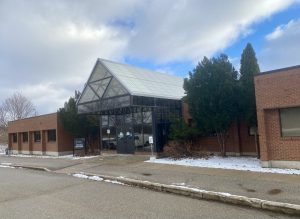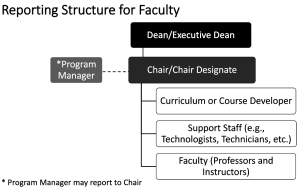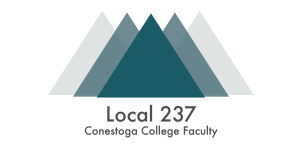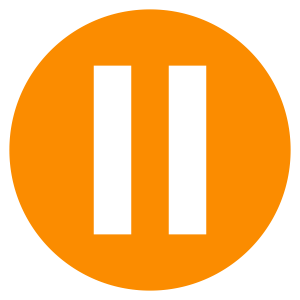1.3 Campuses, Schools, Programs, and People
Identify the College’s organizational and reporting structure for faculty
Conestoga College

Conestoga College has been in operation since 1969. Its website provides information about the history of the College and how to access other pages that provide essential college information for employees.
The College policies, procedures, practices and guidelines page provides all employees with critical policies and procedures that guide their work there.
Conestoga’s Campuses
Conestoga has the largest geographic area of all colleges in Ontario. Conestoga currently has 9 active campuses, with a 10th to open September 2023. You may be scheduled to teach at any of them!
-

Fig 1.3.2. Woodworking Building at Doon Campus by Elan Paulson, CC-BY Brantford
- Cambridge – Downtown
- Cambridge – Fountain Street
- Cambridge – Reuter Drive
- Guelph
- Ingersoll Skills Training Centre
- Kitchener – Doon
- Kitchener – Downtown
- Milton – Parkhill Drive
- Milton -Steeles Avenue
- Stratford
- Waterloo
5-Minute Web Search Activity
Do a web search now!
- Bookmark the College policies, procedures, practices and guidelines
- If you know the campus you’ll be teaching at, find the campus webpage for addresses, campus maps, and parking information.
Conestoga’s Schools

Conestoga College offers various established and emerging career-focused programs across nine academic schools.
- School of Applied Computer Science and Information Technology
- School of Business
- School of Community Services
- School of Creative Industries
- School of Engineering & Technology
- School of Hospitality & Culinary Arts
- School of Interdisciplinary Studies
- School of Health and Life Sciences
- School of Trades & Apprenticeship
Conestoga’s Programs
Conestoga has over 270 programs! See a list of all full-time programs on the Full-Time Programs page to know the program for which your course is required. Note that information about courses and programs of learning (e.g., Continuing Education, Apprenticeship) can be found on the Programs and Courses page.
Academic Handbooks
All programs have full-time and part-time Academic Handbooks that guide the delivery of courses. You should be familiar with the Academic Handbook for your course, which provides key policies, processes, and other important information.
Work Integrated Learning

Work Integrated Learning (WIL) is mandatory in many Conestoga programs. WIL is classroom learning applied to practice! Examples of mandated WIL in a program include:
- co-op placements
- clinical placements
- work terms
Students may also obtain part-time work, summer work, and volunteer work, but these are not considered WIL. WIL also does not include activities offered by the College that appear on students’ co-curricular records. Learn more about students’ co-curricular records in Module 3.
5-Minute Web Search Activity
Do a web search now! Find the
- Policies and procedures that govern the work of all employees
- Academic School that offers the course you teach
- Program your course belongs to in the list of full-time programs
- Link to your Academic Handbook
Faculty Supervisor(s) and Reporting
Conestoga employees fall into one of three categories: Administrative employees, Support Staff, and Academic employees (including the faculty roles of Professor and Instructor, Counsellors and Librarians). Sub-groups within the Academic and Support Staff areas (for example, employees classified as Full-time) are OPSEU union members.
Your Academic Chair is a college administrator and your direct supervisor. Chairs report to Deans or Executive Deans, who report to the VP Academic. Only a Chair or Chair Designate can direct and provide performance management to a faculty member.

Figure 1.3.5 shows a typical reporting structure for staff. Structures may vary by area.
Unless otherwise specified, you should contact your Chair or Chair Designate with questions and issues relating to these and other topics:
- Contract and workload
- Assigned duties
- Student issues
- Academic incidents and offences
- Requested changes to the Instructional Plan
- Sick days and class cancellations
- Early Course Check-in or Student Appraisal of Teaching (SAT results)
In some cases, faculty will report to a Program Manager; in other instances, Program Managers report to Chairs as faculty do. If you are unsure who you should check in with regularly, contact whoever did the hiring meeting with you.
Program Delivery Teams

You may be part of a program delivery team with different yet equally important roles!
Program Coordinators
Program Coordinators assist with program logistics. Program coordinators do not manage faculty, and faculty do not report to Coordinators.
You may work alongside program coordinators to deliver your course and program, respond to student issues, and support program initiatives, including development and review. For example, you would talk to your Program Coordinator about:
- Timetable questions
- Including a library workshop in your course
- How students are receiving program messages
Program Coordinators for full-time programs are listed in each of the Full-Time Programs. Program Coordinator name(s) are found under Program Contacts on the Program Description tab of the program.
Note: There may be other experienced faculty or fellow Academic employees who provide assistance and guidance for your teaching. Be aware that only the Chair/Chair Designate is your supervisor and manages your work.
Support Staff
Regarding program and course delivery, support staff employees provide a range of class, lab, technology, and practice supports. Some support staff further student learning in the classroom or lab but do not teach or evaluate students:
- Technologists
- Practice Application Specialists
- Technicians
These support staff categories may provide practice demonstrations, offer learning opportunities, and give feedback (along with other duties and responsibilities inside or outside the room).
There may be other categories of staff providing some aspect of program delivery–get to know them and the scope of their responsibilities! If you have questions about the scope of the members of the program delivery team, contact your Chair/Chair Designate.
5-Minute Web Search Activity
Do a web search now!
- For more information on faculty employees, visit the Faculty Employee Page.
- Use the full-time Programs page , locate your program, and find your Program Coordinator (or Coordinators in other programs) under Program Contacts on the Program Description tab.
Faculty Union

Ontario Public Service Employees Union (OPSEU) is the faculty union. It comprises divisions by sector, broken into regions (We are Region 2).
Partial load and full-time faculty belong to Local 237 and (along with full-time support staff) are part of the OPSEU union. Part-time and sessional faculty are NOT currently members of the union.
If you are a full-time or partial-load faculty member at Conestoga College, you are covered by the province-wide Academic Employees Collective Agreement. The Collective Agreement covers workload, salaries, and job security. Part-time and sessional faculty are not members of the Union.
Visit the home page of the Faculty Union (Local 237) to learn how to connect with the Union.
See the “Table of Employment Status and Descriptions” below for a list of the faculty categories; the categories are based on assigned teaching contact hours during the teaching period.
Table of Employment Status and Descriptions
|
STATUS |
DESCRIPTION |
|
FULL-TIME |
UNIONIZED
|
|
PARTIAL LOAD |
UNIONIZED
|
|
SESSIONAL |
NON-UNIONIZED
|
|
PART-TIME |
NON-UNIONIZED
|
| Table 1.3.1 |
OPSEU Local 237 Orientation 2020 Revised Aug. 15, 2020.pptx
5-Minute Web Search Activity
Do a web search now!
 Section 1.3 Review
Section 1.3 Review
Please pause and answer these seven practice questions to review and check your learning.
